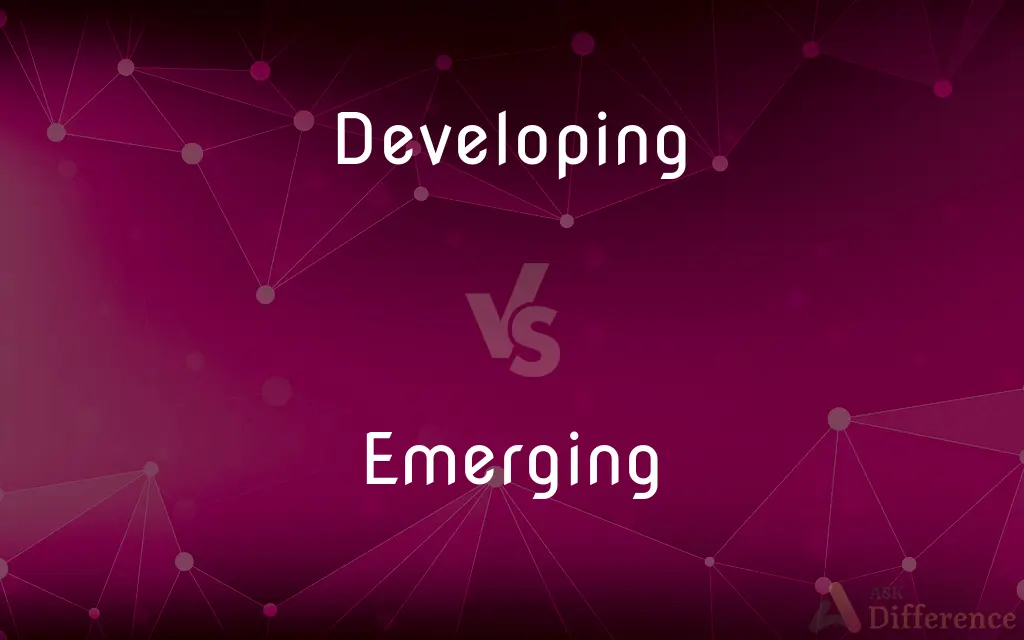Developing vs. Emerging — What's the Difference?
By Tayyaba Rehman & Urooj Arif — Updated on April 3, 2024
Developing countries are in an earlier stage of economic growth, focusing on primary industries, while emerging markets are transitioning towards more advanced economies with diverse industries.

Difference Between Developing and Emerging
Table of Contents
ADVERTISEMENT
Key Differences
Developing countries are characterized by low levels of industrialization, income, and human development index (HDI). They primarily focus on agriculture and other primary sector activities. Whereas, emerging markets are nations evolving from a developing status towards becoming developed, marked by improving industrialization, regulatory quality, and market depth.
In developing countries, the economic structure is heavily reliant on agriculture and extraction industries, leading to lower average incomes and standards of living. On the other hand, emerging markets are experiencing rapid industrial growth, urbanization, and increased investment in diverse sectors, which contributes to higher income levels and better living conditions.
The financial markets in developing countries are typically less mature, with limited access to capital and investment. In contrast, emerging markets boast more developed financial sectors, with growing stock exchanges, increasing foreign direct investment, and access to global capital markets.
Education and healthcare systems in developing countries often struggle with underfunding, limited access, and lower quality. Emerging markets, meanwhile, are making significant investments in these areas, leading to improvements in literacy rates, life expectancy, and overall human capital.
Infrastructure in developing countries tends to be less developed, impacting transportation, communication, and access to services. Emerging markets are rapidly building and upgrading infrastructure, which supports economic growth and improves the quality of life.
ADVERTISEMENT
Comparison Chart
Economic Focus
Primary industries (agriculture, extraction)
Diverse sectors (manufacturing, services)
Income Levels
Generally lower
Higher than developing countries
Financial Market Maturity
Less mature, limited access to capital
More developed, increasing foreign investment
Education and Healthcare
Underfunded, limited access
Improving investment and access
Infrastructure
Less developed
Rapidly improving
Compare with Definitions
Developing
Countries where education and healthcare access is constrained.
Access to quality education in developing countries is often a challenge.
Emerging
Countries experiencing significant improvements in infrastructure.
Emerging markets are investing heavily in building roads and communication networks.
Developing
Nations with limited infrastructure development.
Infrastructure in developing countries often lacks modern transportation networks.
Emerging
Economies transitioning towards developed status.
Emerging markets are attracting more foreign direct investment.
Developing
Countries with low industrialization and HDI.
Many developing countries rely heavily on agriculture.
Emerging
Nations with improving education and healthcare systems.
Emerging markets have made significant strides in increasing literacy rates.
Developing
Nations with lower average incomes and standards of living.
People in developing countries often live below the international poverty line.
Emerging
Nations with rapidly growing industrial sectors.
The industrial sector in emerging markets has been expanding at a fast pace.
Developing
Economies with a primary focus on agriculture and natural resources.
Developing countries frequently export raw materials.
Emerging
Economies with diversifying financial markets.
Financial markets in emerging markets are becoming more accessible to international investors.
Developing
Having a relatively low level of industrial capability, technological sophistication, and economic productivity
Studied the economies of developing nations.
Emerging
Emerging is the title of the only album by the Phil Keaggy Band, released in 1977 on NewSong Records. The album was re-released on CD in 2000 as ReEmerging with a different track listing, including four newly recorded songs by the original band members.
Developing
In the process of development.
A developing foetus
Emerging
Newly formed or just coming into prominence; emergent
Emerging markets.
An overview of the emerging states of Africa in the 1960s.
Developing
Of a country: becoming economically more mature or advanced; becoming industrialized.
Emerging
Becoming prominent; emergent; rising.
Developing
A process of development.
Emerging
Present participle of emerge
Developing
Not industrialized but undergoing industrialization; - sometimes used as a euphemism for "undeveloped"; - of nations.
Emerging
Emergence
Developing
Becoming or arising; as, the rushing yellow of the developing day.
Emerging
Coming into view;
As newly emerging emotions and ideas well up in him
Developing
The process of treating a photosensitive material with chemicals in order to make a latent image visible.
Emerging
Coming into existence;
A nascent republic
Developing
Processing a photosensitive material in order to make an image visible;
The development and printing of his pictures took only two hours
Emerging
Coming to maturity;
The rising generation
Developing
Relating to societies in which capital needed to industrialize is in short supply
Developing
Gradually unfolding or growing (especially as of something latent);
His developing social conscience
After the long winter they took joy in the developing warmth of spring
Developing
Making or becoming visible through or as if through the action of a chemical agent;
He watched as the developing photograph became clearer and sharper
Common Curiosities
What is the significance of financial market maturity in these countries?
Financial market maturity indicates the level of development in a country's financial sector, crucial for attracting investment and supporting economic growth.
What defines a developing country?
A developing country is characterized by low industrialization, income, and HDI, often focusing on agriculture and primary industries.
What are emerging markets?
Emerging markets are nations in transition from developing to developed status, marked by rapid economic growth and industrialization.
How do education systems compare between developing countries and emerging markets?
Developing countries often have underfunded and inaccessible education systems, whereas emerging markets are improving their educational infrastructure and access.
Can a country be both developing and an emerging market?
Yes, the terms are not mutually exclusive; an emerging market is a type of developing country that is further along in its development path.
How does urbanization affect these countries?
Urbanization can lead to economic opportunities and improved access to services, especially in emerging markets.
How do healthcare systems differ between these types of countries?
Healthcare in developing countries is often basic and underfunded, while emerging markets are making strides in improving healthcare access and quality.
How do income levels differ between developing countries and emerging markets?
Developing countries generally have lower income levels, while emerging markets have higher incomes due to economic diversification.
What role does infrastructure play in the development of these countries?
Infrastructure development is crucial for economic growth, with emerging markets investing more aggressively than developing countries.
How does foreign investment affect these economies?
Foreign investment can spur economic growth, with emerging markets particularly benefiting from increased investment flows.
What challenges do developing countries face in becoming emerging markets?
Developing countries face challenges such as political instability, lack of infrastructure, and limited access to education and healthcare.
What impact does industrialization have on these economies?
Industrialization drives economic growth, with emerging markets typically experiencing faster industrial growth compared to developing countries.
How do standards of living compare between developing countries and emerging markets?
Standards of living are generally lower in developing countries compared to emerging markets, which are experiencing improvements in living conditions.
What is the role of agriculture in developing countries?
Agriculture is a primary economic activity in developing countries, providing livelihoods for the majority of the population.
Why are education and healthcare important for economic development?
Education and healthcare are vital for building human capital, essential for sustained economic growth and development.
Share Your Discovery

Previous Comparison
Conscience vs. Intuition
Next Comparison
Chess vs. CheeseAuthor Spotlight
Written by
Tayyaba RehmanTayyaba Rehman is a distinguished writer, currently serving as a primary contributor to askdifference.com. As a researcher in semantics and etymology, Tayyaba's passion for the complexity of languages and their distinctions has found a perfect home on the platform. Tayyaba delves into the intricacies of language, distinguishing between commonly confused words and phrases, thereby providing clarity for readers worldwide.
Co-written by
Urooj ArifUrooj is a skilled content writer at Ask Difference, known for her exceptional ability to simplify complex topics into engaging and informative content. With a passion for research and a flair for clear, concise writing, she consistently delivers articles that resonate with our diverse audience.















































